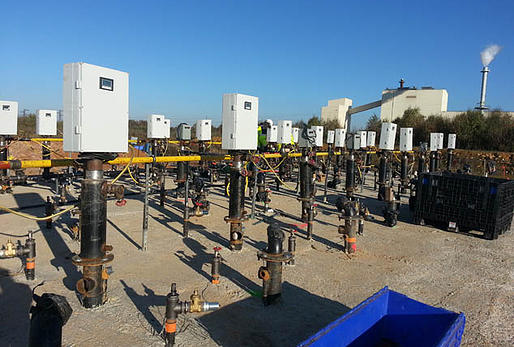


Gas Thermal Remediation
TPS Tech and their Certified Licensees are the sole providers of our patented GTR™ system used to carry out gas thermal conductive heating (TCH) projects. GTR™ is a method of TCH in which individual burners are used to raise the temperature of the subsurface.

In-Situ Thermal Conduction Heating (TCH) by Gas Thermal Remediation (GTR™) is a remediation process whereby heat is applied to subsurface soils and groundwater through an array of vertical or horizontal heater wells coincident with soil vapor extraction (SVE) or multi-phase extraction (MPE) wells. Heat propagates through subsurface soils, groundwater, and bedrock as energy radiates and conducts away from the heater wells operated between 400 and 700°C. Target treatment temperatures for various contaminants and at different sites range from 70°C to 400°C.
As soil, groundwater, and bedrock is heated, adsorbed and liquid phase contaminants are changed to vapor phase through volatilization, or destroyed in situ by a number of mechanisms that include (1) volatilization into vapor phase, (2) steam stripping and distillation into water vapor, (3) mobilization of NAPL to extraction wells via viscosity reduction and increased permeability, (4) hydrolysis, (5) oxidation, and (6) pyrolysis. Generated water vapor, steam, volatilized contaminants, pure phase COC chemicals (i.e. LNAPL and DNAPL) and other natural organic compounds are drawn by vacuum to the SVE and or MPE extraction wells located within and target treatment zone and surrounding areas. These extracted vapors and liquids are treated onsite.
The individual burners are fueled by either natural gas or propane to provide heat to the TCH wells. The heat is transferred to the individual TCH wells as hot combustion air is circulated within the enclosed steel tubing of each TCH well. The hot combustion air is completely isolated from the soil and heating of the subsurface occurs primarily through conduction.
Throughout the heating process the individual burners and proximate temperature/pressure recording points are monitored via a wireless data system. A real time ftp website is used for accessing data remotely. Subzones within the TTZ can be individually controlled, so that temperature gradients and energy consumption may be optimized.
A typical GTR™ system uses the following equipment:
- GTR™-type burners and their respective TCH wells placed in borings
- Vapor extraction wells co-located within TCH well boring
- Separate vapor extraction trenches or vertical wells (as necessary)
- Natural gas connection or mobile propane tank(s)
- Mobile control center and programmable logic controller (PLC) data connection system
- Wireless monitoring, control, and communications system
- Thermocouples and their respective borings
- Vacuum induction blower to supply burner air
- Vapor extraction system to extract soil vapor and apply vacuum to the well-field
- Vapor treatment system to treat soil vapor
- Water/NAPL separator plus water treatment and discharge (Liquid GAC)

- The soil is heated through conduction by a set of pipes filled where hot air is circulated, each of them connected to an individual very high-tech burner. This heating method reduces energy consumption to a minimum.
- The polluted vaporized contaminants are collected through separate perforated pipes and are used as fuel in the burners.
- The whole system is very flexible and portable. Each heating well can have its own length and treatment time, making it the most suitable technology for efficient thermal treatment.
- Our Geothermal and Stability services transform the cost of the remediation into an investment to save money and CO2 emissions in the future.
Benefits of Gas Thermal Remediation
- Scalable to fit any size ISTR project, even small sites in urban areas, under buildings.
- Natural gas or propane supply the energy for subsurface heating.
- Nominal electric power is required (ie. blowers, burner controls, etc.) and when not available (remote sites), a mobile generator can be used for a completely off the grid ISTR system. Note that large and costly power upgrades are not required.
- The use of individually controlled burners allow for burners to be removed from operation as localized areas of the TTZ reach their treatment goals, which translates to energy and cost savings.
- Complete mobilization in as little as 2 weeks.
- No noise, smell, and traffic nuisance for the neighborhood.



